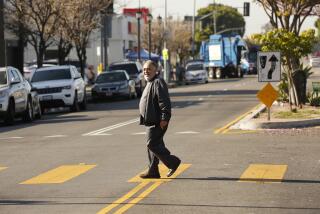Op-Ed: What Stockholm can teach L.A. when it comes to reducing traffic fatalities
New York’s new mayor, Bill de Blasio, has promised to make the streets of his city safer for those who travel them, whether by foot, bicycle or car. How? By following Sweden’s lead.
Over the last 15 years, Stockholm has cut pedestrian deaths by 31% and overall traffic deaths by 45%. Last year, the Swedish city suffered only six traffic deaths, or about 1 per 150,000 residents. New York had nearly five times that rate, and Los Angeles County, with somewhere around 600 traffic fatalities a year, had roughly nine times the death rate of Stockholm.
Sweden’s “Vision Zero” philosophy holds that human error shouldn’t be fatal. When a child runs after a bouncing ball and a speeding car strikes and kills him, for example, that death shouldn’t be accepted simply as an unavoidable tragedy. Rather, it should be studied to see how it might have been averted with better road design or behavioral reinforcement or both.
We already think this way about aviation accidents. When a jet crashes, no one shrugs it off by saying, “Well, accidents happen.” Instead, the government and the industry analyze the contributing factors and do everything they can to prevent such an accident from happening again.
De Blasio is confident he can reduce deaths, and that is in part because previous New York mayors have already shown the way. Last year, 228 people died in crashes in New York, 170 of them pedestrians. That sounds bad, and it is. But in 1990, New York had 701 traffic deaths, with 366 pedestrians killed. And 20 years before that, the city saw nearly 1,000 traffic deaths in a single year. It wasn’t unusual to lose 500 pedestrians annually.
New York’s current traffic fatality numbers compare favorably with other American big cities. But it, along with the rest of America, remains well behind many other global cities, including Paris, London, Hong Kong and Tokyo.
Successful programs need to address two main issues: speed and inattention.
Reducing speed has immediate effects for reasons that are easily understood. Someone hit by a car going 20 mph will live 90% of the time. Someone hit at 40 mph will live only 30% of the time.
Speeding also distorts the judgment of both driver and potential victim. “Drivers overestimate their own ability to stop” and “underestimate the impact” of a crash, says Rune Elvik, a civil engineering professor at Denmark’s Aalborg University. And pedestrians can underestimate the speed of approaching cars, thinking they have more time to cross a street than they do.
Inattention can be caused by distractions — phones, radios, passengers — or simply from a failure to focus on the road.
One way of dealing with both problems involves redesigning streets, adding pedestrian plazas and bike lanes, which make car and truck lanes narrower and remind drivers that they’re in a city where people live, not on a highway where it’s OK to drive fast.
Talk show hosts made fun of former Mayor Michael Bloomberg when he added pedestrian plazas and narrowed roadways at Herald Square (near Macy’s) and Times Square. But the redesigned streets make it absolutely clear to drivers that they share the road, and require them to slow down and pay more attention.
De Blasio has promised more such design changes, focusing particularly on dangerous intersections. This is good public policy. At intersections where the city has changed the design of the streets, fatalities have fallen by a third since 2005, twice the city’s overall rate.
The city is also focusing on ways to gather better data. It intends to add speed cameras at key intersections. And it has directed taxi regulators to explore outfitting taxis with “black boxes” that could record data and sound warnings when drivers go too fast.
The devices would be used not only to deter drivers from breaking the law but also to provide the city with more data on who speeds and where, and to enable the city to crack down on lawbreakers. Police will be able to use the information to deploy manpower, while the transportation department can use it to pinpoint intersections in need of redesign.
Making the streets safer for people rather than faster for cars is not simply a public health measure; it’s also an important step in helping cities to grow. Most cities really can’t grow outward, at least not without making multibillion-dollar investments in new public transit. That means cities need to get denser, which makes it more convenient for people to get around on foot or bicycle.
Richard Snook, owner of Wabi Cycles, has lived in downtown Los Angeles for nearly seven years. He notes that though downtown is adding people, the streets have little capacity for more traffic. Easing traffic requires increasing the number of people getting around without cars — on bicycle or on foot — and Snook notes that there has already “been an increase in the number of cyclists.”
Still, he says, “for the average person, [cycling in Los Angeles] is very daunting.” But L.A.’s new lane markers and other measures for bicyclists are starting to change that. Indeed, the L.A. County
Bicycle Coalition notes that bike trips in the county increased 56% between 2000 and 2010, while the population increased only 3%.
More bicyclists on the street is also good for walkers, since the presence of bicycles forces car and truck drivers to drive more slowly and pay attention.
“It’s kind of goofy that we got ourselves to the point” that road deaths “are accepted,” says Snook.
The good news, though, is we’re less and less willing to accept them every year.
Nicole Gelinas is a fellow at the Manhattan Institute and a contributing editor to City Journal, from which this piece was adapted. Twitter: @nicolegelinas
More to Read
A cure for the common opinion
Get thought-provoking perspectives with our weekly newsletter.
You may occasionally receive promotional content from the Los Angeles Times.










